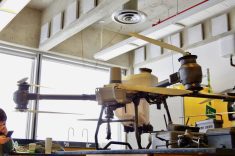For once, it’s not a bad thing if the mummy returns – unless you’re an aphid.
In 2022, pea aphids plagued many Manitoba farmers, said John Gavloski, entomologist with Manitoba Agriculture. Aphids on soybeans also hit economic levels, particularly in the central, east and Interlake regions.
“Some people were caught in a dilemma,” Gavloski told an audience in Clandeboye on Jan. 4.
Read Also

Seeding Indigenous agricultural prosperity
National Circle for Indigenous Agriculture and Food says Indigenous agricultural success needs strong relationships.
“They had economic populations but once again they were noticing lots of dead aphids – something called aphid mummies.”
The concept behind aphid mummies could inspire a horror movie, but they actually benefit farmers. Each mummy is the leftover cuticle or husk of an aphid. A tiny, black parasitic wasp walks along the plant, tapping its antennae. When it finds an aphid, it whips its hind-end around and stabs an egg into the aphid.
“That takes just a fraction of a second,” Gavloski said.

The egg hatches, and the larvae eats the aphid from the inside out. As the larvae matures, the aphid dies and becomes “slightly puffy or mummified,” an article from the University of Massachusetts Amherst says.
“It becomes a house for the wasp larva,” said Gavloski.
When the body-snatching wasp reaches adulthood, it chews its way out of the aphid’s corpse and leaves the mummy behind.
Gavloski said farmers asked him if it was possible to spray for aphids without killing the beneficial insects. Until recently, the only available products were for horticulture, he said.
A new field-crop product could change that. Carbine, a flonicamid-based product from FMC, purports to selectively kill aphids, lygus bugs and a few others by affecting their ability to eat. Carbine is targeted for alfalfa, lentils, field peas and other pulses.
Another creepy phenomenon last year signaled trouble for grasshoppers in parts of Manitoba.
While clearwing and two-striped grasshoppers made a sizable appearance, a grasshopper-killing fungus also reared its head.
Gavloski reported sightings of dead grasshoppers clinging en masse to the tops of plants. Clumps of bugs could be found scattered throughout fields. This is called summit disease.

It’s caused by a fatal fungus called Entomophaga grylli. Grasshoppers pick up spores as they hop about in search of food. The fungus infiltrates their body and multiplies in their bloodstream, Gavloski wrote in a November article about the disease.
As the grasshoppers near death, the fungus causes them to climb to the tops of plants and hang on. Then, when the carcass rots, fungal spores drift over a greater area.
Higher incidence of summit disease in 2022 is likely due to the wet spring, because the fungus thrives in moist conditions, Gavloski said.
Other grasshopper predators prevalent in 2022 were bee fly larvae, blister beetles and field crickets. All three eat grasshopper eggs.
















